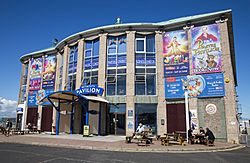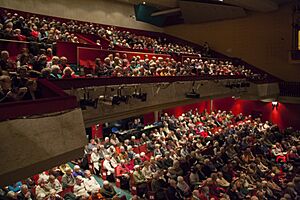Weymouth Pavilion facts for kids

Weymouth Pavilion, July 2016
|
|
| Former names | The Ritz |
|---|---|
| Address | The Esplanade Weymouth DT4 8ED England |
| Operator | Weymouth Pavilion CIC |
| Capacity | 988 (Theatre) 600 (Ocean Room) |
| Construction | |
| Opened | 21 December 1908 |
| Closed | 23 April 1954 (destroyed by fire) |
| Reopened | 15 July 1960 13 July 2013 |
The Weymouth Pavilion is a popular theatre and entertainment spot in Weymouth, Dorset. It used to be called The Ritz. This building has a large theatre with 988 seats. It also has a big room called the Ocean Room, which can hold 600 people for events. There's also a restaurant called the Piano Bar, the Ritz Cafe, and other rooms for meetings and parties.
The first pavilion was built in 1908. Sadly, it was destroyed by a fire in 1954. The theatre you see today was built in its place in 1958. For many years, the local council owned and ran the Pavilion. But since 2013, a special group called a Community Interest Company has been running it. This group is a not-for-profit organization, meaning they use any money they make to help the community. The Pavilion is located right at the end of The Esplanade. It sits between Weymouth Harbour and Weymouth Beach.
Contents
History of the Weymouth Pavilion
The First Pavilion (1908–1954)
Weymouth became a very popular place for holidays by the sea. People wanted a fun place for entertainment. So, in 1907, a competition was held to design a new theatre. The chosen spot was at the end of the Esplanade.
The first pavilion was built in 1908. It was made of wood with a strong steel frame. It cost about £14,150 to build, which also included making more land on the Esplanade. The theatre officially opened on December 21, 1908. In 1914, a man named Ernest Wheeler started running the theatre. He managed it for 25 years.
Later, another theatre opened nearby in 1924. To keep up, the Pavilion also started showing movies.
World War II and the Pavilion
During World War II, the military took over the pavilion. It was used by soldiers, especially a group called No. 4 Commando. In 1940, it housed 800 Moroccan soldiers from the French army. Later, it became a medical center. This was during the time people were being moved from the Channel Islands.
In April 1942, the pavilion was damaged by bombs during an air raid. After that, the British Admiralty used it. They kept it as a post office for the navy until 1947.
The Ritz and the Fire
In 1947, a company called Buxton Theatre Circuit leased the venue. They added a new cinema projection room in 1949. In May 1950, they reopened the theatre as The Ritz. A new management company took over in September 1951.
In January 1954, some repair work began on the building. This included fixing the roof and repainting the outside. But on April 13, 1954, a terrible fire started. Most of the building was destroyed in just one hour. The fire was caused by someone using a blow-lamp incorrectly. The damage cost around £80,000. The council used the building's fire insurance. The remains of the building were then taken down.
Building the New Pavilion (1958–1960)
After a lot of discussion, work began on a new theatre and ballroom in September 1958. The plans were drawn by Samuel Beverley. In 1959, the council held a competition to name the new building. They chose "Weymouth Pavilion" over "The Normandy."
The new pavilion cost £154,000 to build. It officially opened on July 15, 1960. The ballroom had opened a little bit before that.
Plans for the Future (2006–2012)
In 2006, there were plans to redevelop the pavilion and the area around it. This was part of a huge £135-million project. It was supposed to happen between 2007 and 2011, just in time for the 2012 Olympic Games. The plan included a new theatre, a visitor center for the Jurassic Coast, a new ferry terminal, a hotel, a car park, shops, apartments, and a marina. However, this big plan was cancelled in 2009 because of money problems in the economy.
In 2012, a designer named Jeffrey Heintz suggested a new £160-million redevelopment plan. He believed his team could make the pavilion successful under a special trust. This would also save taxpayers a lot of money. But the 2012 Olympic Games were happening soon, so no redevelopment plans could go forward at that time.
Community Takes Over (2012–Present)
In 2012, the Borough Council started looking for ways to save money on the Pavilion. Later that year, they even thought about tearing down the pavilion and building a car park instead. Local people who loved the Pavilion started a petition to save it.
In 2013, the council had more talks about the Pavilion's future. Some ideas included demolishing it, letting a community group run it, or selling the building.
It was suggested that the pavilion should be given to the community instead of being torn down. The official decision was made on February 21, 2013. The council then asked groups to bid to manage the venue for community use. The Pavilion closed on May 13, 2013.
The next month, it was announced that a local businessman named Phil Say had won the bid. He would run the theatre as a nonprofit business. This business would be operated by a new Community Interest Company. The new agreement was signed on July 5, 2013. The Weymouth Pavilion then reopened to the public on July 13, 2013.
In January 2015, it was reported that the pavilion was doing much better under its new management. In 2014, it had over 300,000 visitors and sold more than 60,000 tickets. The next January, the Christmas pantomime Snow White became the most successful show ever at the Pavilion. It sold more tickets than the previous year's pantomime, Aladdin.
See also
 In Spanish: Weymouth Pavilion para niños
In Spanish: Weymouth Pavilion para niños



